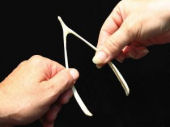
Purpose
To demonstrate the importance of calcium for maintaining strong bones.
Additional information
Those who know what calcium is, raise your hand! Calcium, as many of your moms have told you, is vital for maintaining healthy and strong bones. Weighing in at number 20 on the atomic scale, Calcium (or Ca for those who prefer our element symbols), is the lightest of alkaline metals with a density of only 1.55 g/cm. This soft gray earth metal is the 5th most abundant in the human body, not surprising since it's a vital structural element of healthy bones. Drink your milk, take your calcium supplements, and keep those bones strong!
Sponsored Links
Required materials
- Large empty jar with a lid
- Several chicken bones, preferably a leg bone or drumstick
- Vinegar
Estimated Experiment Time
Only about 10 minutes to set-up and several days (3 to 5) for the bone(s) to become rubbery.
Step-By-Step Procedure
- 1. Make sure your bones for this experiment are thoroughly cleansed, with any meat removed from the bones. Try washing the bones with warm water mixed with a little salt.
- 2. Take a bone and try bending it before placing it in the jar. Notice how hard the bone is before it's placed in the jar.
- 3. Place the bones in the jar.
- 4. Fill the jar with vinegar, just enough so that it completely submerges the bones.
- 5. Place the lid on the jar and secure tightly.
- 6. Leave the bones to soak in the jar for at least 3 to 5 days.
- 7. After several days have passed, open the jar and drain the vinegar. Remove the bones from the jar and rinse under water for a few seconds.
- 8. Try bending the bones now and compare it to when you tried bending the bones in the beginning of the experiment.
Note
Both red wine vinegar and white vinegar will work, but you may want to stick with the white to avoid any chance of staining your clothes or anything around you.
Observation
Why do you think the bone is hard before you place it in the jar? What mineral makes the bone that way? What happens if that mineral that makes the bone hard is extracted? What will happen to the bone? What could you use instead of vinegar to get the same effect? What if you used a bone from a different animal? Try it with a left over pork or beef rib.
Result
The vinegar in the jar, which is a mild acid, breaks down the calcium in the chicken bones. When the calcium dissolves, there is nothing left to keep the bone hard. The soft tissue of the bone is all that remains, which is why it takes on a rubbery nature.
Sponsored Links
Take a moment to visit our table of Periodic Elements page where you can get an in-depth view of all the elements,
complete with the industry first side-by-side element comparisons!